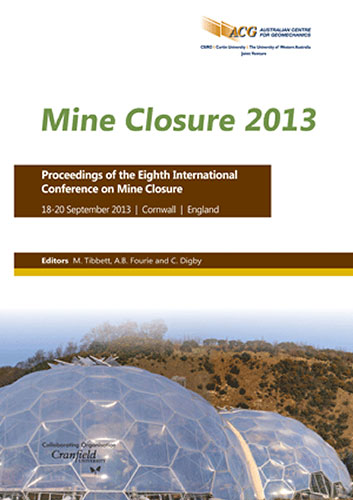A framework for success criteria for mine closure, reclamation and post-mining regeneration

|
Authors: Coppin, NJ |
DOI https://doi.org/10.36487/ACG_rep/1352_41_Coppin
Cite As:
Coppin, NJ 2013, 'A framework for success criteria for mine closure, reclamation and post-mining regeneration', in M Tibbett, AB Fourie & C Digby (eds), Mine Closure 2013: Proceedings of the Eighth International Seminar on Mine Closure, Australian Centre for Geomechanics, Cornwall, pp. 485-493, https://doi.org/10.36487/ACG_rep/1352_41_Coppin
Abstract:
What are the appropriate criteria for judging when a mine closure or reclamation process has been successful? This is a continuing problem for the mining industry and regulators; it also seems to be a very difficult one to nail down. There are many guidelines and frameworks for mine closure and reclamation, but the great majority are based on processes – the ‘means’ rather than the ‘ends’, which are outcomes such as future use, performance and function. Success is often judged in the very short term, or is judged post-facto, with hindsight. Criteria, where they are set, tend to be considered from a single aspect or narrow perspective, such as ecological conditions. This paper attempts to take a fresh look across a whole range of aspects and disciplines to set out a possible framework for setting success criteria, based on objectives and outcomes rather than processes. It does not attempt to review all the criteria and methods published previously, and it does not present a set of criteria that can be used off the shelf. It is, as the title suggests, a suggested framework that can be developed, improved and built on. This paper will consider a number of perspectives: The objectives and outcomes required, in terms of afteruses, regeneration, etc., including hard and soft uses for economic and non-economic purposes. What the criteria, used to measure success against the objectives, are required for – judging an award, relinquishment of responsibility (liability) or sign-off of licence or permit conditions, release of bonds, etc. The timescale – from closure planning and design for closure, through life of mine, progressive reclamation and decommissioning, to active care and long-term passive care stages. Whether the closure and rehabilitation is part of a planned closure, with identified objectives and criteria, or is unplanned forced closure or dealing with abandoned legacy sites, where opportunist approaches may be more applicable. Risk assessment as an important aspect of setting meaningful closure criteria. The danger that ‘criteria’ can become ‘targets’, and the problems that so often occur with a target-based approach. Finally, the paper sets out a framework for selecting and applying criteria, with a suggested outline of the available indicators and metrics that can be used to measure them, grouped under seven headings: ecological, geochemical, engineering/geotechnical, hydrological, economic, cultural and – last – social and community. This paper does not attempt to present all the answers; the author’s purpose is to raise questions and suggest an approach as the basis for discussion for the industry and regulators to take forward.
References:
Ontario Ministry of Northern Development and Mines (1991) Rehabilitation of Mines – Guidelines for Proponents, Sudbury, Ontario.
© Copyright 2025, Australian Centre for Geomechanics (ACG), The University of Western Australia. All rights reserved.
View copyright/legal information
Please direct any queries or error reports to repository-acg@uwa.edu.au
View copyright/legal information
Please direct any queries or error reports to repository-acg@uwa.edu.au